Crown (heraldry)
This article includes a list of general references, but it remains largely unverified because it lacks sufficient corresponding inline citations. (June 2018) |

A crown is often an emblem of a sovereign state, usually a monarchy (see The Crown), but also used by some republics.
A specific type of crown is employed in heraldry under strict rules. Indeed, some monarchies never had a physical crown, just a heraldic representation, as in the constitutional kingdom of Belgium.
Crowns are also often used as symbols of religious status or veneration, by divinities (or their representation such as a statue) or by their representatives, e.g. the Black Crown of the Karmapa Lama, sometimes used a model for wider use by devotees.
A crown can be a charge in a coat of arms, or set atop the shield to signify the status of its owner, as with the coat of arms of Norway.
Physical and heraldic crowns[]
Sometimes, the crown commonly depicted and used in heraldry differs significantly from any specific physical crown that may be used by a monarchy.
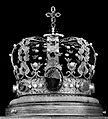
Photograph of the physical crown of Norway
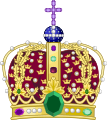
Representation of the physical crown of Norway

The heraldic crown for the King of Norway (1905 pattern)
As a display of rank[]
If the bearer of a coat of arms has the title of baron or higher (or hereditary knight in some countries), he or she may display a coronet of rank above the shield, usually below the helm in British heraldry, and often above the crest (if any) in Continental heraldry.
In this case, the appearance of the crown or coronet follows a strict set of rules. A royal coat of arms may display a royal crown, such as that of Norway. A princely coat of arms may display a princely crown, and so on.
[]
A mural crown is commonly displayed on coats of arms of towns and some republics. Other republics may use a so-called people's crown or omit the use of a crown altogether. The heraldic forms of crowns are often inspired by the physical appearance of the respective country's actual royal or princely crowns.
Ships and other units of some navies have a naval crown, composed of the sails and sterns of ships, above the shield of their coats of arms. Squadrons of some air forces have an astral crown, composed of wings and stars. There is also the Eastern crown, made up of spikes, and when each spike is topped with a star, it becomes a celestial crown.[1]
Whereas most county councils in England use mural crowns, there is a special type of crown that was used by Scottish county councils. It was composed of spikes, was normally shown vert (green) and had golden wheat sheaves between the spikes.[2] Today, most of the Scottish unitary authorities still use this "wheat sheaf crown", but it is now the usual gold.

A depiction of a naval crown

A depiction of an astral crown
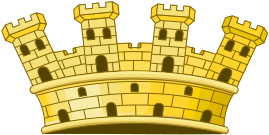
A depiction of a mural crown

A depiction of a celestial crown

A depiction of an eastern crown

A depiction of a camp crown
Commonwealth usage[]

In formal English, the word crown is reserved for the crown of a monarch, whereas the word coronet is used for all other crowns used by members of the British royal family and peers of the realm.
In the British peerage, the design of a coronet shows the rank of its owner, as in German, French and various other heraldic traditions. The coronet of a duke has eight strawberry leaves, that of a marquess has four strawberry leaves and four silver balls (known as "pearls", but not actually pearls), that of an earl has eight strawberry leaves and eight "pearls" raised on stalks, that of a viscount has sixteen "pearls", and that of a peerage baron or (in Scotland) lord of parliament has six "pearls". Between the 1930s and 2004, feudal barons in the baronage of Scotland were granted a chapeau or cap of maintenance as a rank insignia.[citation needed] This is placed between the shield and helmet in the same manner as a peer's coronet. Since a person entitled to heraldic headgear customarily displays it above the shield and below the helm and crest, this can provide a useful clue as to the owner of a given coat of arms.
Members of the British royal family have coronets on their coats of arms, and they may wear physical versions at coronations. They are according to regulations made by King Charles II in 1661, shortly after his return from exile in France (getting a taste for its lavish court style; Louis XIV started monumental work at Versailles that year) and Restoration, and they vary depending upon the holder's relationship to the monarch. Occasionally, additional royal warrants vary the designs for individuals.
In Canadian heraldry, special coronets are used to designate descent from United Empire Loyalists. A military coronet signifies ancestors who served in Loyalist regiments during the American Revolution, while a civil coronet is used by all others. The loyalist coronets are used only in heraldry, never worn.

Monarch St Edward's Crown (medieval)
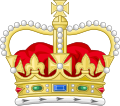
Monarch St Edward's Crown (current)
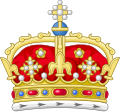
Monarch Crown of Scotland

Monarch Imperial/Tudor Crown
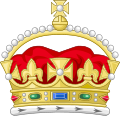
Heir Apparent

Child of a Sovereign

Child of Heir Apparent

Grandchild of a Sovereign[a]

Child of daughter of a Sovereign, if styled Highness[3]

Duke
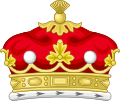
Marquess

Earl

Viscount

Peerage Baron/Lord of Parliament (Scotland)

Feudal Baron (Scotland)

Loyalist military coronet (Canada)

Loyalist civil coronet (Canada)

King of Arms (College of Arms)
Continental usages[]
Precisely because there are many traditions and more variation within some of these, there are a plethora of continental coronet types. Indeed, there are also some coronets for positions that do not exist, or do not entitle use of a coronet, in the Commonwealth tradition.
Such a case in French heraldry of the Ancien Régime, where coronets of rank did not come into use before the 16th century, is the vidame, whose coronet (illustrated) is a metal circle mounted with three visible crosses. (No physical headgear of this type is known.)
Helmets are often substitutes for coronets, and some coronets are worn only on a helmet.
Andorra[]
| Co-Princes |
Bulgaria[]

|
Tsar | 
|
Tsaritsa | 
|
Prince | Older Princesses | Younger Princesses |
France[]
Ancien Régime[]
 King (after the 1500s) King (after the 1500s)
|
 Heir to the throne (Dauphin) Heir to the throne (Dauphin)
|
(fils de France ) |
|
Napoleonic Empire[]
 Emperor
(1st Empire) |
 Emperor
(2nd Empire) |
 Sovereign
Prince |
 Prince Prince
|
 Duke Duke
|
 Count Count
|
 Baron Baron
|
 Knight Knight
|
Bonnet
d'honneur |
July Monarchy[]

|
King of the French |
Georgia[]

|
Georgian Royal Crown, also known as the "Iberian Crown" |
German-speaking countries[]
Holy Roman Empire[]
 Older Imperial Crown Older Imperial Crown
|
 Newer Imperial Crown Newer Imperial Crown
|
 Older Crown of the King of the Romans Older Crown of the King of the Romans
| |
 Newer Crown of the King of the Romans Newer Crown of the King of the Romans
|
 Crown of the King of Bohemia Crown of the King of Bohemia
|
 Archducal hat Archducal hat
|
 Ducal hat of Styria Ducal hat of Styria
|
 Oldest Electoral hat Oldest Electoral hat
|
 Older Electoral hat Older Electoral hat
|
 New Electoral hat & new Ducal hat New Electoral hat & new Ducal hat
|
 Ducal crown Ducal crown
|
 Crown of an heir to a duchy Crown of an heir to a duchy
|
 Princely hat Princely hat
|
 Princely crown Princely crown
|
 Crown of a Landgrave Crown of a Landgrave
|
Liechtenstein[]

|
Prince of Liechtenstein |
Austria[]
 Mural crown of the coat of arms of Austria Mural crown of the coat of arms of Austria
|
Austrian Empire
 Crown of the Emperor of Austria Crown of the Emperor of Austria
|
 Crown of the King of Bohemia Crown of the King of Bohemia
|
 Archducal hat Archducal hat
|
 Archducal crown Archducal crown
|
 Ducal hat of Styria Ducal hat of Styria
|
 Ducal hat Ducal hat
|
 Ducal crown Ducal crown
|
 Princely hat Princely hat
|
 Princely crown Princely crown
|
Germany[]
German Empire
 Crown of the German Emperor Crown of the German Emperor
|
 Crown of the German Empress Crown of the German Empress
|
 Crown of the German Crown Prince Crown of the German Crown Prince
|
 Crown of the King of Prussia Crown of the King of Prussia
|
 Crown of the King of Bavaria Crown of the King of Bavaria
|
 Crown of the King of Württemberg Crown of the King of Württemberg
|
Greece[]

|
Crown of the King of the Hellenes | 
|
The Crown as it appears on the Royal Coat of Arms of Greece |
Hungary[]

|
Holy Crown of Hungary |
Croatia[]

|
Crown of Zvonimir |
Italy[]
Kingdom of Italy (1861-1946)[]
 King (crown of Savoy) King (crown of Savoy)
|
 Heir to the throne (Prince of Piedmont) Heir to the throne (Prince of Piedmont)
|
 Royal prince[c] Royal prince[c]
|
|
Kingdoms of Naples, Sicily, Two Sicilies[]
 King of Naples King of Naples
|
 Heir to the throne (Duke of Calabria) Heir to the throne (Duke of Calabria)
|
 Prince and princess Prince and princess
|
Grand Duchy of Tuscany[]
 Habsburg-Lorraine Grand Dukes of Tuscany Habsburg-Lorraine Grand Dukes of Tuscany
|
Other Italian states before 1861[]
 Crown of San Marino Crown of San Marino
|
 Crown of Napoleonic Italy Crown of Napoleonic Italy
|
 Papal Tiara Papal Tiara
|
 Doge of Venice Doge of Venice
|
 Doge of Genoa Doge of Genoa
|
 Duke of Parma Duke of Parma
|
Low Countries[]
Netherlands[]
 Holy Roman Emperor Holy Roman Emperor
| |||
 King King
|
 Prince Prince(Members of the Royal House, children of the Monarch) |
 Prince Prince(Members of the Royal House, grandchildren of the Monarch) |
 Prince Prince(nobility, for titles granted after 1815) |
 Duke Duke
|
(alternative style) | ||
(Erfridder) |
Belgium[]
The older crowns are often still seen in the heraldry of older families.
 King King
|
 Prince of the Royal house Prince of the Royal house
|
 Prince Prince (nobility, for titles granted after 1815) |
 Prince Prince (nobility, for titles granted during the Ancien Régime) |
 Duke Duke
|
|||
 Count (oldest) Count (oldest)
|
 Viscount Viscount
|
 Baron (older) Baron (older)
| |
(Chevalier/Erfridder) |
Luxembourg[]

|
Grand Duke |
Monaco[]

|
Prince |
Poland and Lithuania[]
 King King
|
 Grand Duke Grand Duke
|
 Prince Prince
|
Portuguese-speaking countries[]
Portugal[]
(1930-1999) |
Kingdom of Portugal (until 1910)
 King King
|
 Heir to the throne (Prince Royal) Heir to the throne (Prince Royal)
|
 Prince of Beira Prince of Beira
|
 Infante Infante
|
|
Brazil[]
| Capital of State of the Federation[b] | City[b] | Town[b] | Village[b] |
Empire of Brazil
 Emperor Emperor
|
 Heir to the throne (Prince Imperial) Heir to the throne (Prince Imperial)
|
 Prince Prince
|
|
Romania[]

|

|

|

|
| Capital | City | Town | Village |
Kingdom of Romania[]

|
King (The Steel Crown of Romania) |
Russia[]
 Emperor Emperor
|
 Crown of the Grand Duchy of Finland Crown of the Grand Duchy of Finland
|
 Monomakh's Cap Monomakh's Cap
|
 Prince Prince
|
Nordic countries[]
Denmark[]
 King King
|
 Crown Prince Crown Prince
|
 Prince (royal family) Prince (royal family)
|
|
Finland[]
This section needs expansion. You can help by . (October 2014) |
During the Swedish reign, Swedish coronets were used. Crowns were used in the coats of arms of the historical provinces of Finland. For Finland Proper, Satakunta, Tavastia and Karelia, it was a ducal coronet, for others, a comital coronet. In 1917 with independence, the coat of arms of Finland was introduced with a Grand Ducal coronet, but it was soon removed, in 1920. Today, some cities use coronets, e.g. Pori has a mural crown and Vaasa a Crown of Nobility.

|
Ducal coronet Satakunta |

|
Comital coronet Savo |
Norway[]
 Heraldic crown of the King |
 Physical crown of the King |
 Physical crown of the Queen | |
Sweden[]
 King King
|
Duke/Duchess | |
 Count Count
|
 Baron Baron
|
 Crown of Nobility Crown of Nobility
|
Serbia[]
 King (medieval) King (medieval)
|
 King (after 1903) King (after 1903)
|
Spanish-speaking countries[]
Spain[]
 King (National arms design) King (National arms design)
|
 King (Monarch's arms design) King (Monarch's arms design)
|
 King (Aragon, Catalonia, Balearics, Valencia) King (Aragon, Catalonia, Balearics, Valencia)
|
 Heir to the throne (Prince of Asturias) Heir to the throne (Prince of Asturias)
|
 Heir to the throne (Prince of Girona) (Aragon, Catalonia, Balearics, Valencia) Heir to the throne (Prince of Girona) (Aragon, Catalonia, Balearics, Valencia)
|
 Infante Infante
|
 Infante (Aragon, Catalonia, Balearics, Valencia) Infante (Aragon, Catalonia, Balearics, Valencia)
|
 Grandee of Spain Grandee of Spain
|
Mexico[]

|
Emperor (1st Empire) |

|
Emperor (2nd Empire) |

|
Prince (1st Empire and 2nd Empire) |
Chile[]
| Municipal Mural Crown |
Non-European usages[]
Bahrain[]

|
King |
Bhutan[]

|
'Raven Crown' of the Kingdom of Bhutan |
Cambodia[]

|
Crown of the Kingdom of Cambodia |
Central African Empire[]

|
Emperor |
Egypt before 1953[]

|
Khedive (-1914) and Sultan (1914-22) |

|
King (1922-53) |
Jordan[]

|
Crown of Jordan |
Morocco[]

|
Heraldic Crown of Morocco |
Oman[]

|
Crown of Oman |
Siam and Thailand[]

|
Great Crown of Victory of the Kings of Siam and Thailand |

|
Phra Kiao (princely coronet, also the emblem of King Chulalongkorn) |
Tonga[]

|
Crown of Tonga |
Other examples[]
 Imperial Crown of Ethiopia Imperial Crown of Ethiopia
|
 Royal Crown of Tahiti Royal Crown of Tahiti
|
 Royal Crown of Hawaii Royal Crown of Hawaii
|
 Royal Crown of Hawaii Royal Crown of Hawaii
|
 Crown of the Shah of Persia Crown of the Shah of Persia
|
 Crown of the Shah of Iran Crown of the Shah of Iran
|
Twig crown of the
Republic of the Congo |
Catholic Church[]

Papal Tiara (Pope)
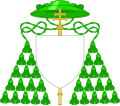
Patriarch

Cardinal

Metropolitan Archbishop

Archbishop
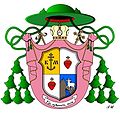
Eastern Catholic prelate, combining elements of both Eastern and Western ecclesiastical heraldry

Apostolic protonotary (Monsignor)
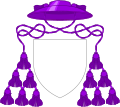
Honorary Prelate (Monsignor)
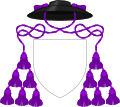
Chaplain of His Holiness (Monsignor)

Bishop
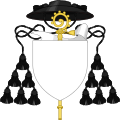
Abbot

Priest
Multinational[]
 Camp crown Camp crown
|
 Celestial crown Celestial crown
|
 Eastern crown Eastern crown
| |
As a charge[]
In heraldry, a charge is an image occupying the field of a coat of arms. Many coats of arms incorporate crowns as charges. One notable example of this lies in the Three Crowns of the arms of Sweden.
Additionally, many animal charges (frequently lions and eagles) and sometimes human heads also appear crowned. Animal charges gorged (collared) of an open coronet also occur, though far less frequently.
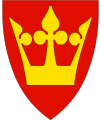
A golden crown appears prominently in the arms of Vestfold, a county in Norway.
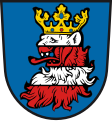
A crowned lion head in the arms of Kreis Biedenkopf, a county in Hesse, Germany (1832-1974)

The Three Crowns, as well as lions and leopards crowned, in the arms of Eric of Pomerania

Both lions and eagles crowned appear in the coat of arms of the Czech Republic.
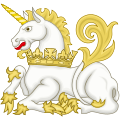
Badge of the Unicorn Pursuivant, a unicorn gorged of a coronet
See also[]
| Wikimedia Commons has media related to Heraldic crowns. |
- Crown jewels
- Imperial crown
- List of monarchies
- Coronet
Notes[]
- ^ Currently, besides the grandchildren of the present Queen Elizabeth II, the current Duke of Gloucester and Duke of Kent, along with Princess Alexandra, are granted the privilege to use the crown of a Sovereign's Grandchild as they are the grandchildren of a former sovereign, George V.
- ^ Jump up to: a b c d e f This standard has many exceptions.
- ^ The dukes of Genoa were granted the privilege to use the crown of a royal prince though they were only princes of the blood
References[]
- ^ Mackinnon of Dunakin, Charles (1968). The Observer's Book of Heraldry. Frederick Warne & Co. Ltd. p. 73.
- ^ Moncreiffe, Iain; Pottinger, Don (1953). Simple Heraldry Cheerfully Illustrated. Thomas Nelson and Sons. p. 58.
- ^ Cox, Noel The Coronets of Members of the Royal Family and of the Peerage. Archived 2018-01-04 at the Wayback Machine Originally published in (1999) 22 The Double Tressure, the Journal of The Heraldry Society of Scotland 8-13. Acceded 8 April 2017
- ^ Boutell, Charles (1914). Fox-Davies, A.C. (ed.). Handbook to English Heraldry, The (11th ed.). London: Reeves & Turner. pp. 104–156.
- ^ Ströhl, Hugo Gerard (1899). Heraldischer Atlas. Stuttgart.
- Crowns in heraldry
- Heraldic charges













































